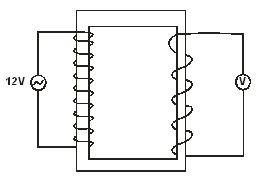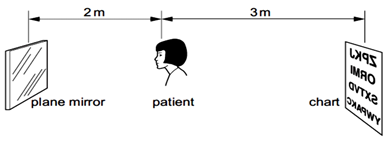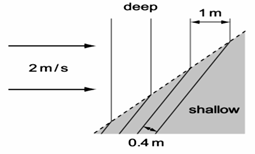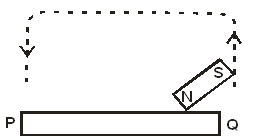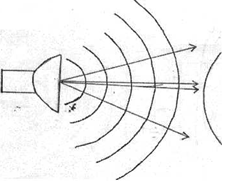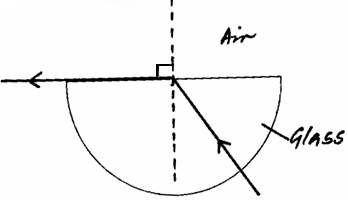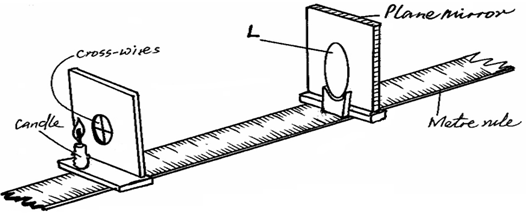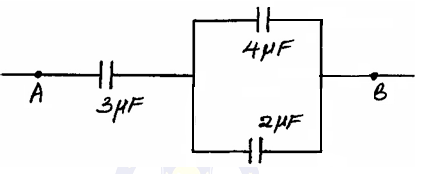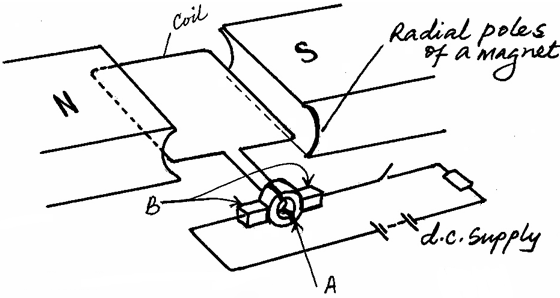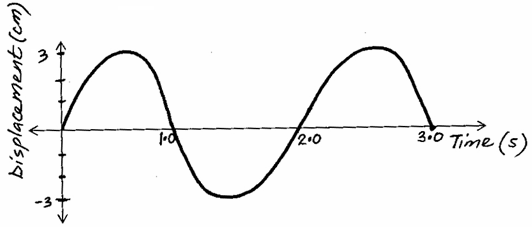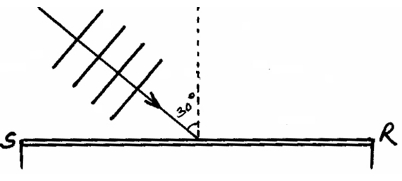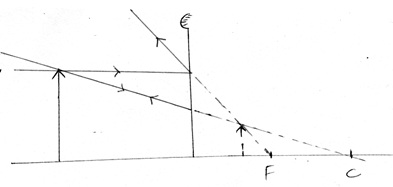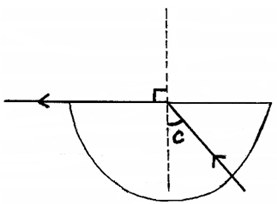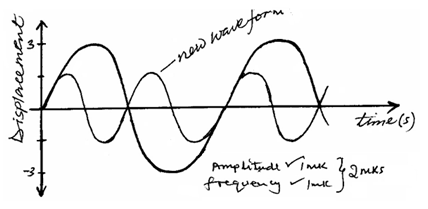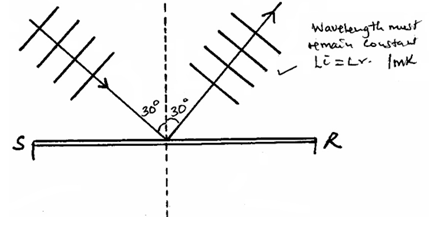INSTRUCTIONS TO CANDIDATES
- This paper consists of 13 questions.
- Answer ALL the questions.
- ALL working MUST be clearly shown.
SECTION A: 25marks
- The chart below shows an arrangement of different parts of the electromagnetic spectrum.
Radio wave A Infrared rays B Ultra-violet X-rays - Name the radiation represented by A ………………………(1mark)
- State one use of radiation represented by B (1mark)
- An object O is placed in front of convex mirror as shown in the diagram below.
Complete the diagram to locate the position of the image, 1. (3 marks) - The figure below shows a wire carrying current whose direction is out of the paper. The wire is placed in a magnetic field.
- Indicate on the figure the direction of the force F, acting on the wire. (1mark
- State what would be observed on the wire if the direction of the current is reversed. (1 mark)
- Figure 5 below shows a simple transformer connected to a 12v a.c source and an a.c voltmeter.
Determine the reading on the voltmeter. (3marks) - The diagram shows a patient having her eyes tested. A chart with letters on it is placed behind her and she sees the chart reflected in a plane mirror.
Determine how far away from the patient, the image of the chart is seen. (2marks) - State Snell’s law. (2mark)
- Waves pass from deep water to shallow water and refraction occurs.
Calculate the speed of the waves in the shallow water. (3marks) - The diagram below shows a ray of light striking the plane at 35° as shown below. State the angle of reflection. (1 mark)
-
- The figure below shows an iron bar being magnetized by stroking it with a magnet.
Indicate on the iron bar the polarity of resulting magnet. (1mark) - State two uses of soft magnetic materials. (2marks)
- The figure below shows an iron bar being magnetized by stroking it with a magnet.
- An echo sounder of a ship transmits sound waves to the depth of the sea and receives the echo after 2.4 seconds. If the speed of sound in water is 1600ms−1 , determine the depth of the sea.
(3 marks) - It is observed that when a charged body is brought near the cup of a positively charged electroscope, the divergence of the leaf increases. State the type of charge on the body. (1mark)
Section B: 55 Marks
-
- A student stands some distance from a high wall and claps his hands
- What two measurements would need to be made in order to determine the speed of sound? (2marks)
- Describe how you would make use of these measurements (2marks)
- The speed of sound in air is 330m/s. How far from the wall would you stand? Choose an answer from the following distances 10m, 200m,500m. Give reasons why you did not choose each of the other two distances. (3marks)
- The balloon filled with carbon dioxide can act like a lens and focus sound from a loud speaker. On to the microphone, Figure 6 show waves produced by loud speaker moving toward the balloon.
- Complete the diagram to show what happens to the sound waves when they have passed through the balloon and moves towards the microphone. (2marks)
- The loud speaker is now moved toward the balloon. This results in less sound at the microphone. Explain why there is less sound at the microphone (1mark)
- he frequency of the sound emitted by the loud speaker is 1020Hz. Calculate the wavelength of the sound wave in air where its velocity is 340m/s (2marks)
- A student stands some distance from a high wall and claps his hands
-
- State the meaning of the term critical angle as applied in refraction of light. (2marks)
- The figure shows a ray of light incident on a glass-air interface.
- Show on the diagram the critical angle, c. (1mark)
- Given that the refractive index of the glass is aηg , and that the critical angle c = 42º, determine the value of is aηg . (3 marks)
- The figure shows an experimental set up consisting of a mounted convex lens L, cardboard screen with cross-wires at the centre, a plane mirror, a metre rule and a candle.
Describe how the set-up may be used to determine the focal length, f, of the lens. (4 marks)
-
- State two properties of electric field lines. (2marks)
- The figure below shows part of a circuit containing three capacitors.
- Calculate the effective capacitance between A and B. (3marks)
- Given that the potential difference (p.d.) across AB is 10V, determine the total charge flowing through the circuit. (2marks)
- State how an increase in thickness affects electrical resistance of a conductor. (2marks)
-
- The figure below shows parts of a simple electric motor.
- Name the parts labeled A and B. (2marks)
- State the function of each of the parts named in part (i) above. (2marks)
- State the advantage of using curved poles of a magnet over plane poles. (1mark)
- Explain the significance of copper coil as part of an electric motor. (2marks)
- The graph in the figure below shows the displacement of a pendulum bob from its rest position as it varies with time.
- Determine the amplitude of the oscillation. (1mark)
- Determine the time for one complete oscillation. (1mark)
- On the same graph, draw a sketch graph which represents a pendulum swinging with half the amplitude and twice the frequency. (2marks)
- Plane water wave fronts are incident onto reflector SR as shown in the figure below. Show on the diagram the nature and direction of the reflected wave fronts. (2marks)
- The figure below shows parts of a simple electric motor.
-
- The figure below shows three resistors as shown.
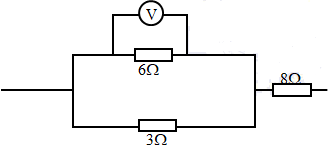
If the voltmeter reads 4V, find the- ffective resistance (3marks)
- Current through the 3Ω resistor. (2marks)
- Potential difference across the 8 resistor if the voltage total voltage in the circuit is 10V
(1 mark)
-
- What is meant by the term “terminal voltage” as used in current electricity? (1mark)
- A cell supplies a current of 2.0A when connected to a 0.6Ω resistor and 1.5A when the same cell is connected to a 0.9Ω resistor. Find the e.m.f and the internal resistance of the cell. (4 mark)
- The figure below shows three resistors as shown.
MARKING SCHEME
-
- A - microwave
- B - for vision
-
-
-
- moves on the opposite side.
-
- Ns/Np = Vs/Vp
5/10 = Vs/12
Vs = 6V - 3m+2m=5m
- the ratio of sine of angle of incidence to sine of angle of refaction is the same for a pair of media.
- f =V/ λ V₁/λ₁=V₂/λ₂
2/1=V₂/0.4
V2=0.8m/s - 90 - 35 = 55°
-

-
- used in transformer cores
- used in electric motors
- d=½st
½ x 1600 x 2.4 = 1920m - negative charges
SECTION B
-
-
-
- Time taken for n number of claps. The claps should concide with the echos
- The distance between the civil and walls
- Sound has to travel to the wallls and reflected back to the coil.
Distance travelled will be n echoes.
Total distance travelled = n × 2d = 2nd
Speed of sound = 2nd/t - 200m;
- 10m is short distance mand timing will be iinaccurate.
- 500m is too long for sound to travel through and be reflected back. Energy will have been lost along the way.
-
-
-
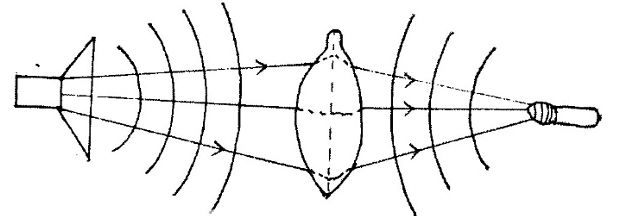
- When the sound goes through the balloon, it is focused to one point, hence changing the position the sound becomes mless; (refracted)
- V = fλ
340 = 1020 × λ
λ = 340
1020
= 0.3333m;
-
-
-
- Angle of incidence in optically dense medium for which the angle of refraction in optically less dense medium is 90º. ✓1 (1mk)
-
-
Labeling ✓1 (1mk) - aηg = 1 ✓1
Sin C
= 1 ✓1
Sin 42°
∴ aηg = 1.4945 ✓1 (3mks)
-
-
- Move the cardboard with crosswire along the metre rule until a sharp image of the cross-wires is formed alongside the object cross-wires. ✓1
- Measure the distance between the lens and the cardboard, ✓11 this is equal to the focal length, f, of the lens.
- Repeat the procedure✓1 and find the average value of f. ✓1 (4mks)
-
-
- They never cross each other.
- They are close to each other where the field is strong and far apart where it is weak.
- They are directed towards the direction in which a free positive charge would move if placed at the particular point in the field.
- Start at 90º from the positive charge and end on the negative charge at 90º. Any 2 (2mks)
-
- Parallel; Co = C1 + C2 = (4 + 2)µF = 6µF ✓1
Series 1 = 1 + 1.
CT C1 CT
= 1/3 + 1/6
1 = 3 ✓1
CT 6
CT = 6/3 = 2μF ✓1 - Q = CV = 2 x 10µC
= 20µC ✓1 (1mk)
- Parallel; Co = C1 + C2 = (4 + 2)µF = 6µF ✓1
- Electrical resistance decreases ¹ when thickness of a conductor increases. (1mk)
-
-
-
-
- A: Split ring (commutator). ✓1
- B: Carbon brushes. ✓1 (2mks)
-
- A (Split ring/commutator).
- To reverse the direction of current in the coil after every half turn which allows continuous rotation of the coil. ✓1 (1mk)
- B (Carbon brushes).
- To provide electrical connection to the coil. ✓1 (1mk)
- A (Split ring/commutator).
- Concentrates magnetic field towards the coil. ✓1 (1mk)
- When current flows through it, it experiences a force, ✓¹ and motion ✓¹ is produced (rotation). (2mks)
-
-
- Amplitude = 3cm ✓¹ from the graph. (1mk)
- Time for 1 complete oscillation = 2.0 seconds ✓¹ (1mk)
-
-
-
-
-
- RP=(R1R2)/(R1+R2)
RS=(R1+R2)
(3X6)/(3+6)+8
= 10Ω - V=IR
I = 4/3
= 1.333A - 10 − 4 =6V
- RP=(R1R2)/(R1+R2)
-
- pd across a cell when it is supplying current
- E = IR+Ir
E = (2X0.6)+2r E=1.8V,r = 0.3Ω
E = (1.5+0.9)+1.5r
-
Download Physics Paper 2 Questions and Answers - Sunrise Pre Mock Exams 2023.
Tap Here to Download for 50/-
Get on WhatsApp for 50/-
Why download?
- ✔ To read offline at any time.
- ✔ To Print at your convenience
- ✔ Share Easily with Friends / Students



